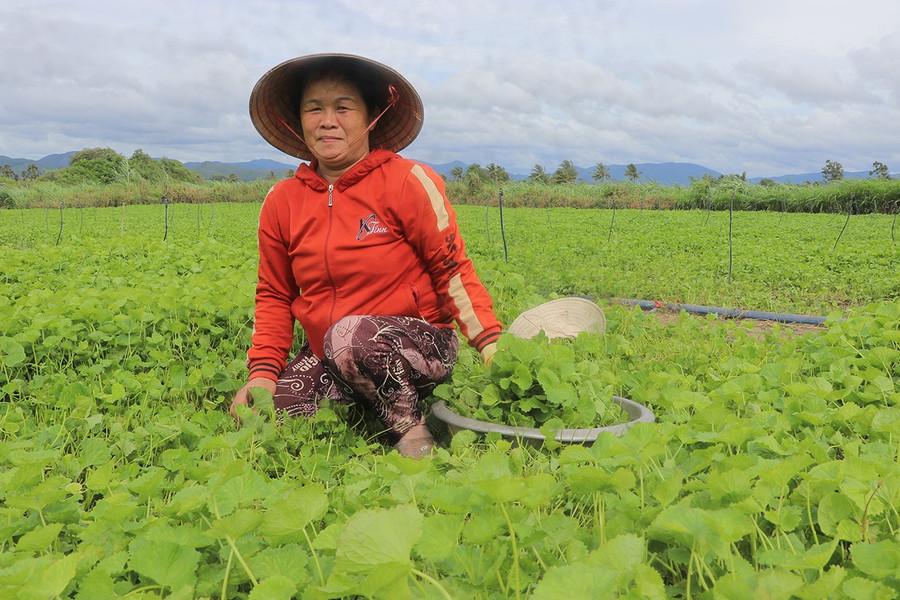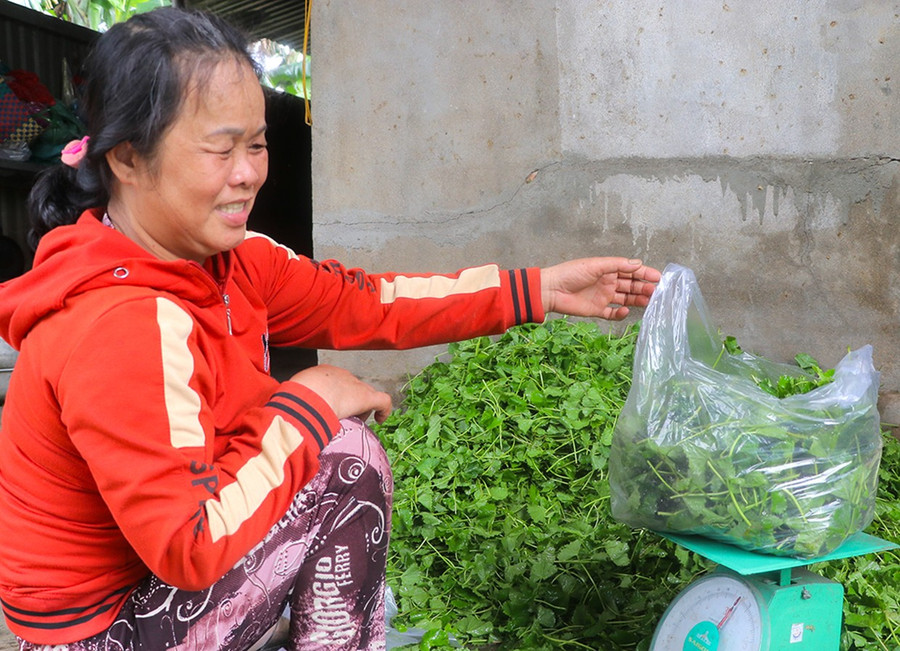
Mrs. Nguyen Thi Anh's family has more than 6,000 square meters of land specializing in growing some types of vegetables such as: mustard greens, Malabar spinach, water spinach, cabbage. At one point, Mrs. Anh switched to growing cucumbers, bitter melon, snow peas or herbs. When harvesting vegetables, she came across young green pennywort bushes growing along the edge of the field or in the vegetable beds, Mrs. Anh picked them up to process into many different dishes or make juice. Many times she could not eat all of them, so she sold them to earn extra income. From here, Mrs. Anh came up with the idea of growing pennywort to supply the market.
Ms. Anh said: At first, she set aside a plot of land to try planting a few pennywort bushes. After nearly a month, the pennywort grew, the shoots stretched out and covered the ground. From there, she trimmed the young, densely growing plants and planted them in new land. But this method of propagation was very time-consuming, so she asked a relative to buy 2 kg of pennywort seeds to sow like other common vegetables, waiting for the plants to mature before planting.
While waiting for the seeds, Ms. Anh improved the garden soil, added organic fertilizer and installed an automatic misting irrigation system. “In order to reduce the burden of initial investment costs and have a regular source of income, I gradually converted to expand the pennywort growing model. From 2016 to 2018, pennywort covered more than 6,000 m2, providing regular harvests,” Ms. Anh said.
According to Ms. Anh, pennywort is easy to grow and care for. If cared for properly, it can be harvested in just 26-28 days. Pennywort likes light and humidity, so in the dry season, water twice a day, early morning and late afternoon. In the rainy season, create deep trenches around the garden to drain water quickly and limit flooding.
“To keep the vegetable garden green and lush, every year, I fertilize it with more than 1 ton of decomposed cow manure and mixed with biological fertilizer once a month. I researched and studied how to soak ginger, garlic, and chili in alcohol as a pesticide to prevent pests in the pennywort garden. Along with that, I grow organically, so I am trusted and highly appreciated by the people,” Ms. Anh shared.
In order to bring fresh vegetables to the market, early in the morning or late in the afternoon, Mrs. Anh and her husband and workers harvest, then focus on picking off old leaves and packaging to supply to markets in Dak Po district, An Khe town. "Every day, I cut and sell 35-40 kg of pennywort, selling for 15-17 thousand VND/kg, earning nearly 200 million VND/year. Compared to some leafy vegetables in the area, pennywort is easier to sell, with a more stable income," said Mrs. Anh.
According to Ms. Anh, the weeding step takes the most time and effort. Meanwhile, the house is short of people, and she and her husband are old, so the weeding and vegetable harvesting steps require hiring one regular worker with a salary of 150,000 VND/day. At peak times, she hires 2-3 more people to harvest and pack vegetables with a salary of 20-25,000 VND/hour.

Having worked for Mrs. Anh's family for many years, Ms. Ly Thi Nhanh (Tan Tu village) clearly understands the process of caring for, weeding, and fertilizing the pennywort garden. Ms. Nhanh said: The humidity in the pennywort garden is very high, creating favorable conditions for the plants to grow and develop; this is also the ideal condition for weeds to thrive. Therefore, every day, she harvests vegetables for about 1-2 hours, the remaining time is spent weeding, pruning, and replanting in the gaps to ensure the vegetable garden is always dense and even.
“The work is easy but requires diligence and meticulousness. Although the income is not high, it is stable. My house is near my workplace so I can take care of the housework and take my children to school,” Ms. Nhanh confided.
Talking to reporters, Ms. Pham Thi Ngoc Loan - Vice Chairman of Tan An Commune People's Committee - said: "Tan An is a large vegetable granary of Dak Po district. For many years, people have applied scientific advances in production. Some households have boldly introduced new vegetable varieties to increase income.
Mrs. Nguyen Thi Anh’s family is the first household in the commune to develop a model of growing pennywort. This has turned wild pennywort into a commodity product; added to the list of local leafy vegetables and brought a stable income to the family.”
Source: https://baogialai.com.vn/trong-rau-ma-mang-lai-thu-nhap-on-dinh-post328491.html


![[Photo] Solemn opening of the 12th Military Party Congress for the 2025-2030 term](https://vphoto.vietnam.vn/thumb/1200x675/vietnam/resource/IMAGE/2025/9/30/2cd383b3130d41a1a4b5ace0d5eb989d)
![[Photo] General Secretary To Lam, Secretary of the Central Military Commission attends the 12th Party Congress of the Army](https://vphoto.vietnam.vn/thumb/1200x675/vietnam/resource/IMAGE/2025/9/30/9b63aaa37ddb472ead84e3870a8ae825)
![[Photo] Panorama of the cable-stayed bridge, the final bottleneck of the Ben Luc-Long Thanh expressway](https://vphoto.vietnam.vn/thumb/1200x675/vietnam/resource/IMAGE/2025/9/30/391fdf21025541d6b2f092e49a17243f)

![[Photo] President Luong Cuong receives President of the Cuban National Assembly Esteban Lazo Hernandez](https://vphoto.vietnam.vn/thumb/1200x675/vietnam/resource/IMAGE/2025/9/30/4d38932911c24f6ea1936252bd5427fa)
![[Photo] The 1st Congress of Phu Tho Provincial Party Committee, term 2025-2030](https://vphoto.vietnam.vn/thumb/1200x675/vietnam/resource/IMAGE/2025/9/30/1507da06216649bba8a1ce6251816820)
































































































Comment (0)